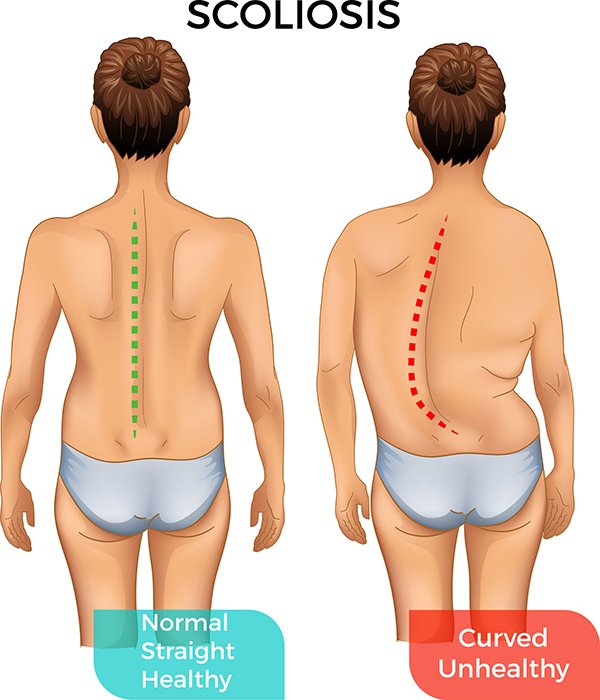Scoliosis is defined as a sideways curvature of the spine that most often is diagnosed in adolescents. Nevertheless, scoliosis can actually happen in people of all ages with a wide range of causes. Most cases of scoliosis are mild grade, even though some curves might get worse as children grow. Severe scoliosis with noticeable changes can be disabling, affecting self-esteem and confidence. Particular if one pursues a career as a flight attendant, this condition might be considered as an exclusion criterion among other health issues. Being aware of scoliosis signs and regular screening substantially contribute to effective and timely treatments before serious complications arise. Not only to enhance the mobility, but appropriate treatment also improves patient’s quality of life while restoring self-confidence.
Get to know scoliosis
Scoliosis is a spinal deformity in which the spine has a sideways curve. The curve is usually “C” or “S” –shaped. A sideways curvature of the spine subsequently causes uneven shoulders, waist, hips or leg lengths which impacts body movement, range of motion and balance. Scoliosis can be classified into several types, hinging upon age groups and related causes. Idiopathic scoliosis (infantile, juvenile and adolescent) with no definite cause is the most common type of scoliosis. Prevalence and curve severity are higher in girls than boys. Scoliosis is often diagnosed in children aged over 10 when a sideways curve becomes clearly noticeable. In general, a curve is considered significant if it is greater than 10 degrees. Curves exceeding 30 degrees often require treatments.
- In case of moderate or severe scoliosis, noticeable curves usually urge the parents to bring their children to see and consult with the spine doctors. If indicated, treatment can be initiated during childhood before the curves get more progression.
- In case of mild curves, scoliosis can develop unnoticed since the angle of the curve gradually appears and usually does not cause pain. Occasionally, teachers, friends and sports teammates are the first to notice a child’s scoliosis when performing physical activities. For adults who want to apply for certain jobs such as flight attendant, scoliosis can be accidentally detected from chest X-ray in an initial medical assessment.

Signs and symptoms of scoliosis
Sign and symptoms of scoliosis may widely vary, depending on disease severity and individual conditions.
- Mild scoliosis: If the curves are mild, there is usually no abnormal sign or symptom.
- Moderate and severe scoliosis: Curves exceeding 30 to 40 degrees might cause back pain as the result of back muscle imbalance and pressure on the intervertebral discs and facet joints. As scoliosis worsens, more noticeable changes include uneven hips and shoulders, prominent ribs and a shift of the waist and trunk to the side, resulting in low self-esteem and confidence. If the curve is severe, it can affect the functions of the heart and lung with the presence of relevant symptoms such as weakness, fatigue, chest pain and breathing difficulties.
Self-examination for scoliosis
- If scoliosis is suspected in a child, parents can easily conduct examination test by letting a child stand in front of the mirror. Then the parents can observe both sides of shoulder whether they are uneven or one shoulder blade appears more prominent than the other.
- A common at-home self-examination test for scoliosis is Adam’s forward bend test. This test requires a child to stand, bring feet together, reach their arms straight forward with the palms together and bend at the waist until his or her back is a flat plane, allowing arms to hang while knees remain straight. The parent or observer examines a child from behind, looking for an uneven lower back, uneven upper back or uneven hips.

Diagnosis of scoliosis
Scoliosis is usually confirmed through a physical examination and imaging tests, including plain x-rays, CT scan (computed tomography) and MRI scan (magnetic resonance imaging). The curve is measured by the Cobb Method in which the angle between intersecting lines drawn perpendicular to the top and the bottom of the spine is the Cobb angle.

Treatment of scoliosis
Scoliosis treatments vary, depending on the severity of the curve and maturity.
- Once the curve is noticed, parents are advised to seek medical assistance provided by expert spine surgeons, enabling accurate diagnosis and effective treatments.
- Children who have very mild curves usually do not require any treatment, although they may need regular checkups to closely monitor if the curve is worsening as they grow. When reaching adolescent period and the bones have stopped growing, mild curves usually resolve without any treatment.
- In children with curves exceeding 30 degrees, wearing a brace might be recommended especially if child’s bones are still growing. Braces do not actually reverse the curve, but it largely prevents the curve from getting worse that might, in some cases, need spine surgery. Braces are discontinued when there is no further change in a child’s height which varies greatly by individual.
- For severe curve more than 40 degrees, scoliosis surgery might be suggested to help straighten the curve and prevent it from getting worse. Surgical options include spinal fusion and expanding rods.
Scoliosis can affect people at all ages with different severity degrees and complications. In children, parents should regularly observe any signs and symptoms that might indicate scoliosis in their children. If scoliosis is suspected, immediate medical attention should be sought to obtain accurate diagnosis while treatment can be planed accordingly. However, scoliosis in adults is usually mild without being noticed. In such a case, mild curves rarely cause pain and limit daily activities unless the condition progresses. To pursue some careers such as a flight attendant, medical assessment including scoliosis screening is essential to ensure that all assigned duties can be effectively and safely conducted without limitations. Treatments of scoliosis, both non-surgical and surgical approaches are determined by the severity of the curves while taking patient’s quality of life and aesthetic concern into consideration.